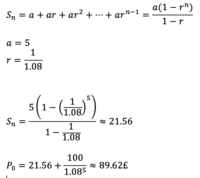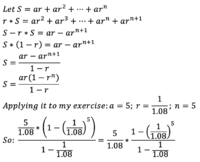Hi everyone,
I hope I am not posting in the wrong category, please do let me know and accept my apologies if I did.
I am trying to understand how did my lecturer get the equation he used to answer an exercise involving bonds. I have attached three pictures below to better illustrate what I am referring to:
Picture 1 - The initial formula that was given during our lectures (C = Coupon payment; P_0 = Price of the bond):

Picture 2 - The exercise, and how I used the formula to find the answer (we assume that the coupon's Face value is 100):

Picture 3 - The solution

As you can see, the solution does not use the same formula. Although both methods lead to the same answer and I could just stick with the initial formula, I cannot sleep at night if I do not understand how his method works. I have tried to figure out how did he go from what I have done in Picture 2, to what he has done in Picture 3.
So far, I have only come to the conclusion that his method is basically following this "template":

However, I do not understand how do we go from the formula in Picture 1, to the formula above. There must be a relation between the two as they give the same answers. I just can't figure it out, I think I must be missing something or lack knowledge.
Could anyone help me understand please ?
Regards.
I hope I am not posting in the wrong category, please do let me know and accept my apologies if I did.
I am trying to understand how did my lecturer get the equation he used to answer an exercise involving bonds. I have attached three pictures below to better illustrate what I am referring to:
Picture 1 - The initial formula that was given during our lectures (C = Coupon payment; P_0 = Price of the bond):
Picture 2 - The exercise, and how I used the formula to find the answer (we assume that the coupon's Face value is 100):
Picture 3 - The solution

As you can see, the solution does not use the same formula. Although both methods lead to the same answer and I could just stick with the initial formula, I cannot sleep at night if I do not understand how his method works. I have tried to figure out how did he go from what I have done in Picture 2, to what he has done in Picture 3.
So far, I have only come to the conclusion that his method is basically following this "template":
However, I do not understand how do we go from the formula in Picture 1, to the formula above. There must be a relation between the two as they give the same answers. I just can't figure it out, I think I must be missing something or lack knowledge.
Could anyone help me understand please ?
Regards.
Last edited:




